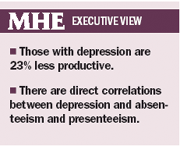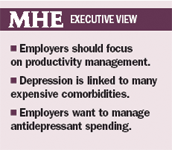Depression can be a detriment to workplace productivity
The times they are a changin'," written and sung by Bob Dylan, was a popular protest song in the 1960s, and those words hold true today in the dynamic healthcare industry. The American industrial nation bred musculoskeletal problems but today's workplace presents new problems-depression and related conditions-the greatest impact on productivity, says Sean Sullivan, president and CEO of the Institute for Health and Productivity Management in Scottsdale, Ariz., and a member of the Managed Healthcare Executive editorial advisory board.
THE TIMES THEY ARE A CHANGIN'," written and sung by Bob Dylan, was a popular protest song in the 1960s, and those words hold true today in the dynamic healthcare industry. The American industrial nation bred musculoskeletal problems but today's workplace presents new problems-depression and related conditions-the greatest impact on productivity, says Sean Sullivan, president and CEO of the Institute for Health and Productivity Management in Scottsdale, Ariz., and a member of the Managed Healthcare Executive editorial advisory board.

A survey conducted by the National Alliance on Mental Illness shows that individuals with depression and limited access to treatment incur an average of nearly three times the annual out-of-pocket costs for medication, psychotherapy and other treatment costs than those with less restricted access-$4,312 versus $1,496.
Awareness of depression in the workplace dates back to the 1980s, when the National Institute of Mental Health (NIMH) introduced the National Worksite Program. It encourages employers nationwide to recognize untreated depression and to stimulate the adoption of corporate policies and practices that promote early recognition, quality care, return to work and on-the-job support for individuals with depressive illness.
In a paper written by Sullivan in 2003 in Health & Productivity Management, he said that awareness doesn't always translate into action, but the number of employer-sponsored employee assistance programs (EAPs) has grown from 68% in 2001 to 71% this year, and 70% of companies offer mental health insurance, according to the Society for Human Resource Management. Contributing to awareness by employers is the federal Americans With Disabilities Act (ADA), which mandates that employers must make accommodations for employees with mental health problems in the workplace.
The incentive is there: employers who provide higher quality evaluation and treatment of depression and anxiety will see overall medical costs fall, employees missing fewer days of work and productivity rising, according to an article in the Journal of Occupational and Environmental Medicine last year, which shows that decreasing mental health services to cut costs may actually increase costs.
A NEW PERSPECTIVE
The focus on depression is changing with an emphasis on measuring productivity, recognizing the high indirect costs of depression and strategies that can improve presenteeism-lost productivity while on the job.

The Castleton Group steps into companies and establishes EAP programs as well as offers a new health plan with mental health benefits. The new plan gives employees resources to self-assess online and offers wellness programs and disease management programs with third-party nurses coaching members that have been identified with depression. The next step, he says, is training supervisors how to manage depression in the workplace and better communicate resources to their employees.
Vicki Schweitzer, senior vice president, Aon Consulting, health and benefits practice in San Francisco, sees depression management moving from a focus on the condition and medical treatment to an emphasis on how well employees are coping in the work environment and how effectively the workplace supports optimal health. Schweitzer recommends a change in therapy modality by allowing more treatment by professionals, which may cost more for care but should offset other medical costs.
Breaking Down Health Plans, HSAs, AI With Paul Fronstin of EBRI
November 19th 2024Featured in this latest episode of Tuning In to the C-Suite podcast is Paul Fronstin, director of health benefits research at EBRI, who shed light on the evolving landscape of health benefits with editors of Managed Healthcare Executive.
Listen
In this latest episode of Tuning In to the C-Suite podcast, Briana Contreras, an editor with MHE had the pleasure of meeting Loren McCaghy, director of consulting, health and consumer engagement and product insight at Accenture, to discuss the organization's latest report on U.S. consumers switching healthcare providers and insurance payers.
Listen